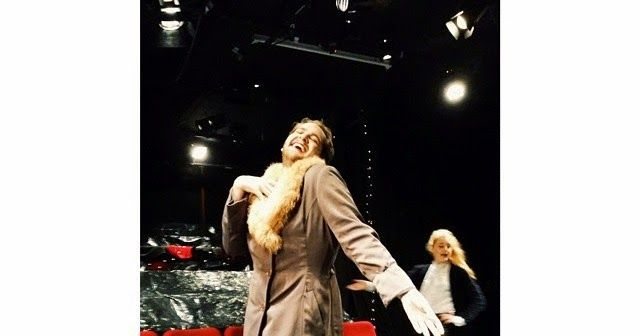Circa Theatre / May 2015
Circa Theatre staged its first production in April 1976 and in the succeeding years gained a reputation as one of New Zealand's liveliest and most innovative theatres.
- Tagged as:
- theatre
- performingarts
-
-
A Crazy Ride
- Circa Theatre
- This week on drama* on the waterfront, Director Kerryn Palmer talks about the crazy ride that is the Circa season of Second Afterlife.
- Accepted from drama* on the waterfront posts
- Tagged as:
- waterfront
Circa Theatre, Taranaki Street, Te Aro, Wellington, Wellington City, Wellington, 6011, New Zealand (OpenStreetMap)
-
-
-

commedia dell’arte
- Circa Theatre
- This week on drama* on the waterfront, Colleen McColl, publicist for A Servant to Two Masters, delves into the commedia dell’arte style of theatre commedia dell’arte = ‘comedy of the profession’, ‘theatre of the professional’, ‘comedy of art’ One of the most interesting things about working as a publicist is delving into other various aspects of the production and finding out about things not previously known. A Servant to Two Masters offered me a wonderful chance to look more closely at commedia dell’arte. Google is a wonderful friend! It appears commedia dell'arte originated in streets and market places of Italy during the Italian Renaissance. Commedia was a hugely popular form of theatre with street performers. They offered improvised stories usually representing fixed social types, stock characters, such as foolish old men, mischievous servants and young lovers. Actors joined the company very often at a young age and in each production played one character – it became their specialty. They spent their whole careers with that same company. As they aged they would moved into other roles eventually ending up as the old master. It was known as a colourful and extremely theatrical art form which allowed improvised scenarios that facilitated a comic plot to arrive at a humorous climax, with a happy ending. The performers, who used masks with exaggerated comic features to draw additional attention to themselves and complement their physical and acrobatic skills, eventually teamed up in troupes of actors, often with a travelling stage, to firmly establish commedia as a genre in it's own right by the mid-1500s. They performed outside and relied on various props in place of extensive scenery. These "commedia troupes" performed for and were accessible to all social classes. Language was no barrier, with their skilful mime, stereotyped stock characters, traditional lazzi's (signature stunts, gags and pranks), masks, broad physical gestures, improvised dialogue and clowning they became widely accepted wherever they travelled. In later years, the tradition spread all over Europe, eventually adopting a major French influence where many of the scenarios were scripted into commedia-style plays. It is from the commedia world where such characters as Arlecchino (Harlequin), Columbine, Punchinello (Punch), The Doctor, The Captain and Pantalone emerged. It was fascinating to learn that during this period, commedia dell’arte was the only form of theatre where women were allowed on stage. A Servant to Two Masters was originally written in 1745 by Carlo Goldoni as part of the commedia dell’arte style of theatre which was still very popular at the time. He was commissioned to devise a play for a famous Harlequin. The story goes that Goldoni wrote it with a lot of room for improvisation (the scenario was pinned to the side of the stage), as was the tradition at that time, and then went away and left them to it. The production was a huge success but when he returned he was appalled by the indulgence of the actors. In a fit of pique he wrote down a text for the players to learn and thus dealt a fatal blow to the centuries-old tradition of commedia dell’arte. It was the birth of farce as we know it today. Award winning dramatist Lee Hall (The Pitmen Painters, Billy Elliot) has adapted Goldoni’s A Servant to Two Masters for our current production at Circa. He offers us a fabulous new, rapid fire version with the language updated to now to create a pacey, action-packed physical comedy. In light of my Google time travelling, I am astounded by Lee Hall’s ability to adapt and re-boot this timeless classic so that it is relevant, funny and highly entertaining to a contemporary audience. BRAVO MR CARLO GOLDONI! BRAVO MR LEE HALL! All Photographs by Stephen A'Court. A Servant to Two Masters runs until 30 May. Tickets available online: www.circa.co.nz
- Accepted from drama* on the waterfront posts
- Tagged as:
- waterfront
Circa Theatre, Taranaki Street, Te Aro, Wellington, Wellington City, Wellington, 6011, New Zealand (OpenStreetMap)
-
-
-

the audience loves Don Juan
- Circa Theatre
- This week on drama* on the waterfront, we're two weeks into the four-week season of Don Juan, and it has received heaps of praise from audience and reviewers alike! So far audience members have said: “I went to this show and haven't laughed so hard in a long, long time.
- Accepted from drama* on the waterfront posts
- Tagged as:
- waterfront
Circa Theatre, Taranaki Street, Te Aro, Wellington, Wellington City, Wellington, 6011, New Zealand (OpenStreetMap)
-
-
-

Young And Hungry Servants
- Circa Theatre
- The Young and Hungry Arts Trust Ambassadors are a group of keen bean Year 12 & 13 students, who attend shows at Circa and others theatres throughout the year and write reviews.
- Accepted from drama* on the waterfront posts
- Automatically tagged as:
- theatre
- waterfront
Circa Theatre, Taranaki Street, Te Aro, Wellington, Wellington City, Wellington, 6011, New Zealand (OpenStreetMap)
-
-
-

Proud to Celebrate 25 Years of Making You Laugh
- Circa Theatre
- This week on *drama on the waterfront, The Improvisors are proud to celebrate 25 Years of making you laugh! By Tim Gordon Tim Gordon, actor and facilitator, celebrates 25 years of The ImprovisorsHarris Street.
- Accepted from drama* on the waterfront posts
- Tagged as:
- waterfront
Circa Theatre, Taranaki Street, Te Aro, Wellington, Wellington City, Wellington, 6011, New Zealand (OpenStreetMap)
-